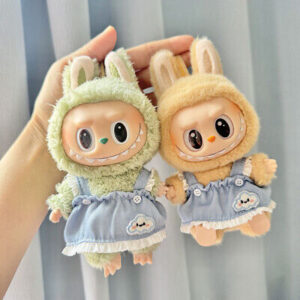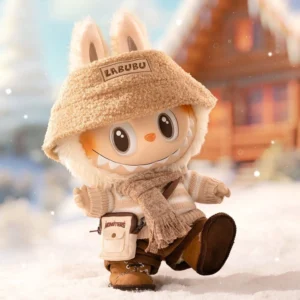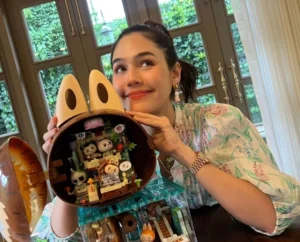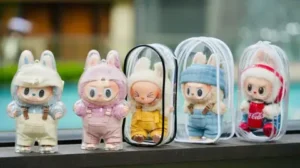 Love it or hate it, Labubu, the quirky elf-like doll from the Chinese toy brand Pop Mart, has become a global sensation. Once regarded as a curious monster, Labubu now counts celebrities such as Rihanna, Dua Lipa, Kim Kardashian, and Lisa from Blackpink among its fans. Eager buyers often queue for hours, sometimes sparking scuffles, just to get their hands on one.
Love it or hate it, Labubu, the quirky elf-like doll from the Chinese toy brand Pop Mart, has become a global sensation. Once regarded as a curious monster, Labubu now counts celebrities such as Rihanna, Dua Lipa, Kim Kardashian, and Lisa from Blackpink among its fans. Eager buyers often queue for hours, sometimes sparking scuffles, just to get their hands on one.
“I feel a real sense of achievement when I get one,” says fan Fiona Zhang. This craze has nearly tripled Pop Mart’s profits and some argue that it has quietly increased China’s cultural influence. But how did this odd little creature capture the world’s attention?
What Exactly Is Labubu?

This question continues to puzzle many. Even those who know about Labubu find it hard to explain its wild popularity. Labubu is both a fictional character and a brand. The name itself doesn’t have a specific meaning; it belongs to a creature from “The Monsters” toy series, created by Hong Kong-born artist Kasing Lung.
Each doll features a vinyl face on a plush body, characterized by pointy ears, wide eyes, and a mischievous grin showing exactly nine teeth. The internet remains divided: some find the dolls irresistibly cute, while others think they are downright strange. According to its official retailer, Labubu is “kind-hearted and always wants to help, but often ends up doing the opposite.”
Labubu appears in multiple editions of The Monsters series, including “Big into Energy,” “Have a Seat,” “Exciting Macaron,” and “Fall in Wild.” The Labubu universe also introduces other characters such as tribe leader Zimomo, her boyfriend Tycoco, and friend Mokoko, each inspiring their own popular dolls. To casual observers, many of these figures may look alike, but collectors can easily spot the differences. Thanks to Labubu’s soaring popularity, these other characters are also flying off the shelves.
Who Sells Labubu?

Labubu is sold by Pop Mart, a Chinese toy company that found major success with its “blind box” sales model, where buyers only discover which figure they’ve purchased after opening the box. In 2019, Pop Mart secured the rights to Labubu through a partnership with artist Kasing Lung, nearly a decade after founder Wang Ning launched the company in Beijing as a small variety store, akin to a pound shop.
Pop Mart’s breakthrough came in 2016 with the launch of its first blind box series featuring Molly dolls, created by Hong Kong artist Kenny Wong. The success of that line paved the way for Labubu’s rise to global fame. However, it was Labubu that truly propelled Pop Mart’s rapid growth. In December 2020, the company went public on the Hong Kong Stock Exchange, and its shares surged over 500% in just one year.
Pop Mart has since evolved into a major global retailer, operating more than 2,000 automated vending machines called “roboshops” worldwide. Labubu dolls are now available in physical and online stores across more than 30 countries, including the US, UK, Australia, and Singapore. However, due to overwhelming demand, some outlets have temporarily paused sales. By 2024, international markets accounted for nearly 40% of Pop Mart’s total revenue.

Labubu’s popularity has reached such heights that Chinese customs officials recently reported seizing over 70,000 counterfeit dolls. Still, this phenomenon didn’t occur overnight; it took years for these elfin creatures to fully penetrate the mainstream market.
Labubu’s rise began post-pandemic in China around late 2022, as people sought emotional escape. According to China expert Ashley Dudarenok, the character’s “charming but chaotic” vibe resonated with a growing anti-perfectionism mindset. While many trends in China remain local, Labubu quickly spread across Southeast Asia and beyond. Fiona, a Canadian fan, first heard about it from Filipino friends in 2023. She was drawn in by its cuteness and the growing popularity: “The more popular it gets, the more I want it,” she says, despite her husband’s confusion over her obsession with doll colors at her age.
Affordability also contributed to Labubu’s allure. While second-hand prices have skyrocketed, Fiona notes that the original cost, ranging from CA$25 to CA$70, is reasonable: “It’s about the same as a bag charm, so most people can afford it,” she says.
Labubu’s global fame soared in April 2024 when K-pop star Lisa began sharing photos with the dolls. Soon after, other celebrities jumped on the bandwagon: Rihanna was spotted with one on her Louis Vuitton bag, Kim Kardashian showcased her collection on Instagram, and David Beckham posted a photo of a Labubu gifted by his daughter.
Now, Labubu dolls are everywhere from social media feeds to the hands of friends, coworkers, and even strangers on the street.
What’s Behind the Labubu Obsession?

In truth, no one really knows. Like many viral trends, Labubu’s appeal seems to be a mix of timing, attractive design, and internet randomness. However, China is embracing the buzz. State media outlet Xinhua hails Labubu as proof of “Chinese creativity and culture” resonating globally, alongside other rising cultural exports like Black Myth: Wukong and Nezha
Analysts are taking notice too, remarking that Labubu’s unique appeal and charm might mark a new chapter for Chinese creative industries as they gain traction in international markets.

 Love it or hate it, Labubu, the quirky elf-like doll from the Chinese toy brand Pop Mart, has become a global sensation. Once regarded as a curious monster, Labubu now counts celebrities such as Rihanna, Dua Lipa, Kim Kardashian, and Lisa from Blackpink among its fans. Eager buyers often queue for hours, sometimes sparking scuffles, just to get their hands on one.
Love it or hate it, Labubu, the quirky elf-like doll from the Chinese toy brand Pop Mart, has become a global sensation. Once regarded as a curious monster, Labubu now counts celebrities such as Rihanna, Dua Lipa, Kim Kardashian, and Lisa from Blackpink among its fans. Eager buyers often queue for hours, sometimes sparking scuffles, just to get their hands on one.









